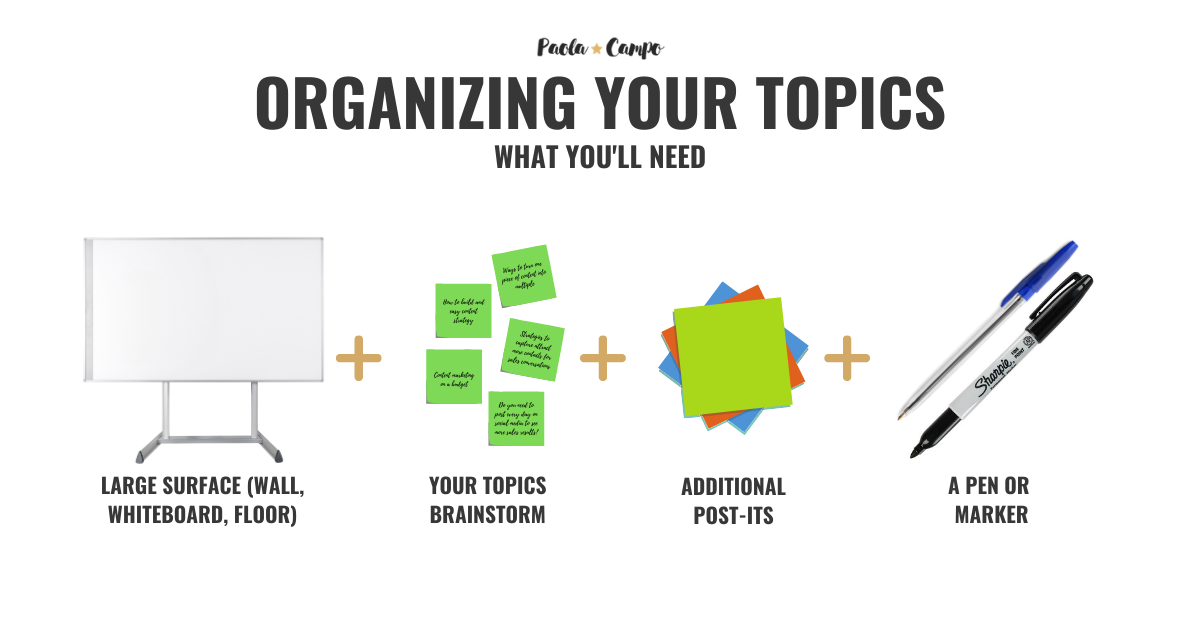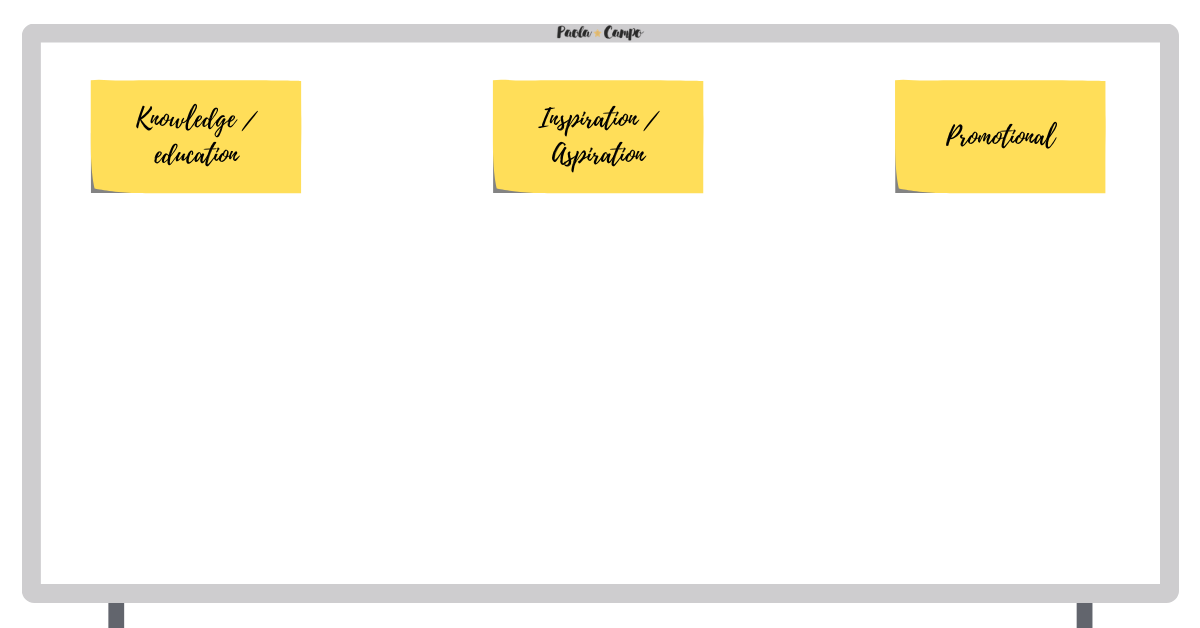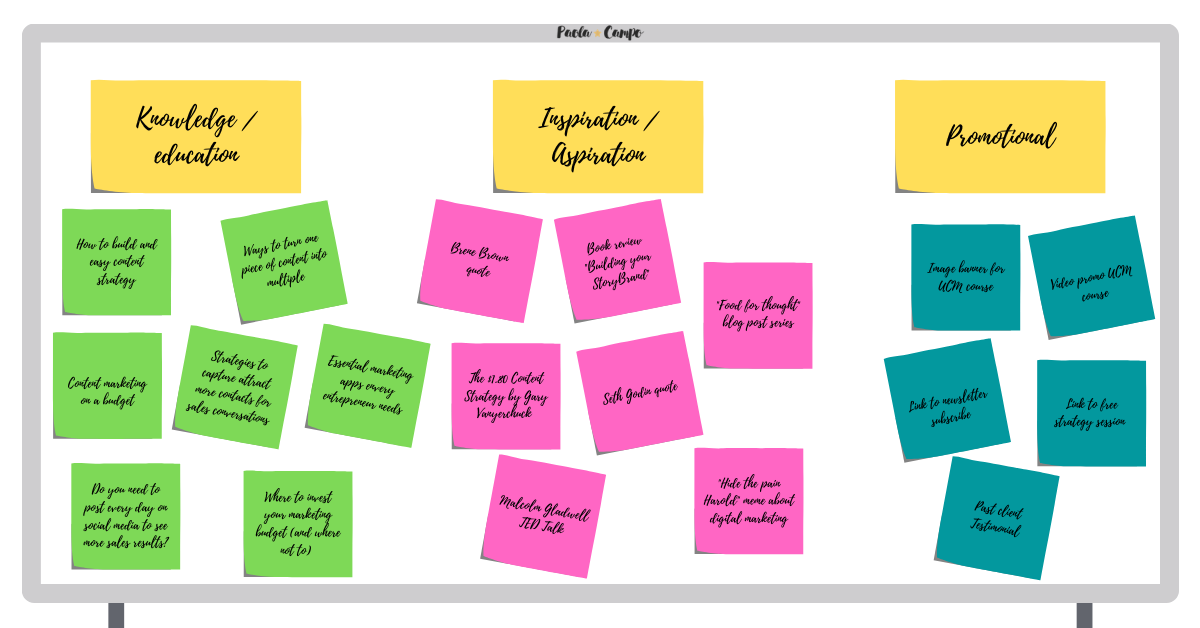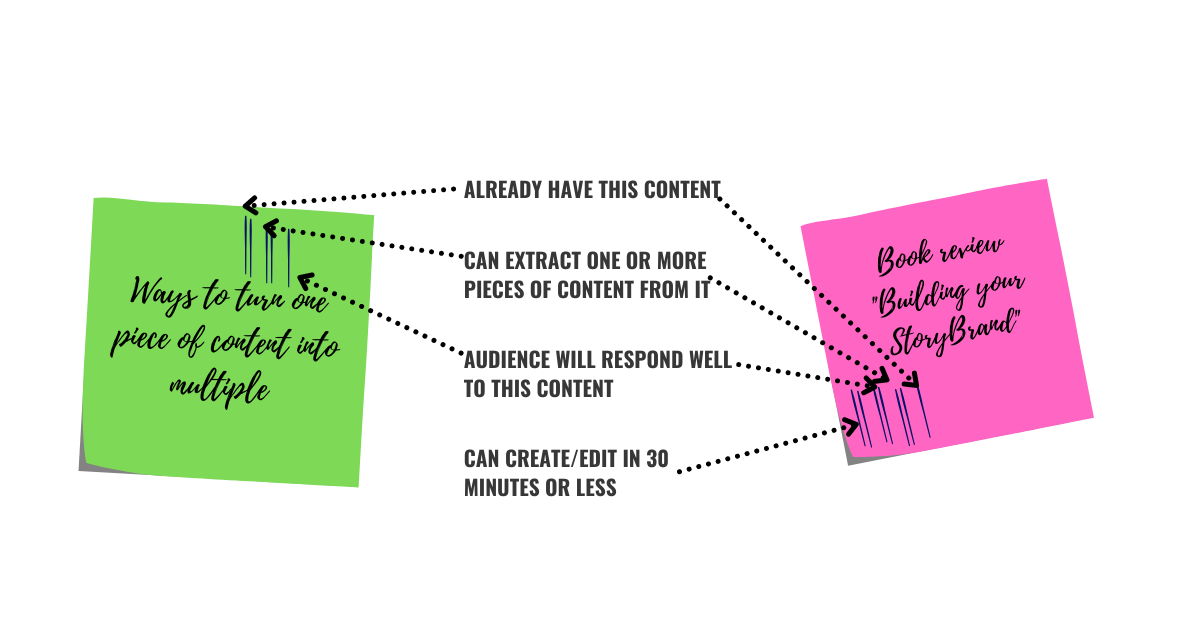Section 2: Planning and building your content strategy
2.3 Organize your content topics list
Creating, planning, and publishing content takes time and effort that can sometimes feel like a full-time job! Organizing and prioritizing your content topics will make the process flow smoothly (without taking up a lifetime!)

It’s time to prioritize!
This part of the process is crucial to help you generate your potential clients’ interest in your business. For the next exercise, you’re going to need the following items:
Take three blank post-its and create the following headings:
- Knowledge / Education
- Inspiration / Aspiration
- Promotional
Make three columns with these headings on the surface of your choice. It should look something like this.
Take your post-its and place them in the first two columns accordingly.
- Knowledge / Education: Actionable tips and knowledge that helps your audience immediately. That’s everything you brainstormed in section 2.1 and the additional topics you identified in section 2.2 when searching for keywords and top questions.
- Inspiration / Aspiration: Content that motivates your audience to think, reflect, and act. These are topics you identified in the “must-read/watch” part of section 2.2 are also relevant here.
Out of all the content you create, 80% should belong in these two categories. They represent the free value for your potential clients to get to know you and recognize you as an expert who can help them.
Let’s look at what my content topics for my ideal client, Alice, could look like within those categories.
| Knowledge / education | Inspiration / aspiration |
| How to build and easy content strategy |
Brene Brown quote |
| Ways to turn one piece of content into multiple | Book review “Building your StoryBrand” |
| Content marketing on a budget | “Food for thought” blog post series |
| Strategies to capture/attract more contacts for sales conversations | The $1.80 Content Strategy by Gary Vanyerchuck |
| Essential marketing apps every entrepreneur needs | Seth Godin quote |
| Do you need to post every day on social media to see more sales results? | Malcolm Gladwell TED Talk |
| Where to invest your marketing budget (and where not to) | “Hide the pain Harold” meme about digital marketing |
The remaining 20% and last column belong to the Promotional category. These are the concrete sales pitches and promotional material for your products and services. You’ve got something to sell, and you share with the world what it is you have to offer.
Take your post-its again and write down ideas for promotional content. But don’t just say, “buy this.” Here are some examples of promotional content:
- Your product or service’s concrete benefits
- Special offers or promotions you’re currently running
- Testimonials from past clients (not stories, but direct quotes)
Some of my promotional items to attract Alice could be:
| Knowledge / education | Inspiration / aspiration | Promotional |
| How to build and easy content strategy |
Brene Brown quote |
Image banner for UCM course |
| Ways to turn one piece of content into multiple | Book review “Building your StoryBrand” | Link to newsletter subscribe |
| Content marketing on a budget | “Food for thought” blog post series | Link to free strategy session |
| Strategies to capture / attract more contacts for sales conversations | The $1.80 Content Strategy by Gary Vanyerchuck | Video promo UCM course |
| Essential marketing apps every entrepreneur needs | Seth Godin quote | Past client testimonial |
| Do you need to post every day on social media to see more sales results? | Malcolm Gladwell TED Talk | |
| Where to invest your marketing budget (and where not to) | “Hide the pain Harold” meme about digital marketing |
The final step in prioritizing your content topics are production and publishing. Let me tell you; this could be a difficult step. I know it is for me because my content is very close to my heart, and this part of the process sometimes feels like picking my favorite child.
But it is a vital step to create your content calendar.
Grab a pen (I would not recommend a marker if you’re using your wall or floor as a surface) and assign points to each topic based on the criteria listed below:
| You already have this content (with or without minimal edits*) | 2 points |
| You can extract one or more extra pieces of content from it (like pictures or quotes) | 2 points |
| You can create/edit the content in 30 minutes or less | 2 points |
| You can create/edit the content in up to 1 hour | 1 point |
|
You know your audience will respond well to this content (based on their past engagement or response to similar content) |
1 point |
*Examples of these are fixing some typos, removing references to an offer past due, changing an image.
Here are a few examples of how I assign points to two of my content topics for my ideal client, Alice:
Once you have assigned points to your content list, sort them from highest number to lowest number of points per category. When you’re ranking these topics on your list, you do not assign more value to specific topics over others. You are giving scheduling and production priority to your content.
The top of the list represents your “low hanging fruit,” or the content that will take you little to no time to produce. This is the content that will buy you time in creating the stuff at the bottom of the list and still make you look to your audience like you’re a bonafide content machine.
My list of content topics ranked from highest to lowest looks something like this:
| Knowledge / education | Inspiration / aspiration | Promotional | |||
| 6 |
Ways to turn one piece of content into multiple |
6 |
Book review “Building your StoryBrand” |
4
|
Image banner for UCM course |
| 5 | Do you need to post every day on social media to see more sales results? | 5 | “Food for thought” blog post series | 3 | Link to newsletter subscribe |
| 4 |
Essential marketing apps every entrepreneur needs |
4 | Brene Brown quote | 3 | Link to free strategy session |
| 2 |
Where to invest your marketing budget (and where not to) |
4 |
Seth Godin quote |
3 | Past client testimonial |
| 1 | How to build and easy content strategy | 2 | The $1.80 Content Strategy by Gary Vanyerchuck | 1 |
Video promo UCM course |
| 1 | Content marketing on a budget | 1 | Malcolm Gladwell TED Talk | ||
| 1 | Strategies to capture / attract more contacts for sales conversations | 1 | “Hide the pain Harold” meme about digital marketing |
Considering a regular social media publishing schedule (that doesn’t require daily posting), this list of topics should be enough for about six weeks of content.
You can repeat this process of brainstorming, organizing, and prioritizing once a month to ensure you always have a steady stream of content ready to implement. The more you do this exercise, the easier it will be to generate ideas. I dare say you’ll be getting so many ideas all the time; you’re going to need a special idea file to capture them.
In the next section, we’re going to put all of this into action. It’s implementation time!
Free Courses
Duis egestas aliquet aliquet. Maecenas erat eros, fringilla et leo eget, viverra pretium nulla. Quisque sed augue tincidunt, posuere dui tempor.
Premium Courses
Duis egestas aliquet aliquet. Maecenas erat eros, fringilla et leo eget, viverra pretium nulla. Quisque sed augue tincidunt, posuere dui tempor.
Ready to get started?
Get in touch, or create an account





